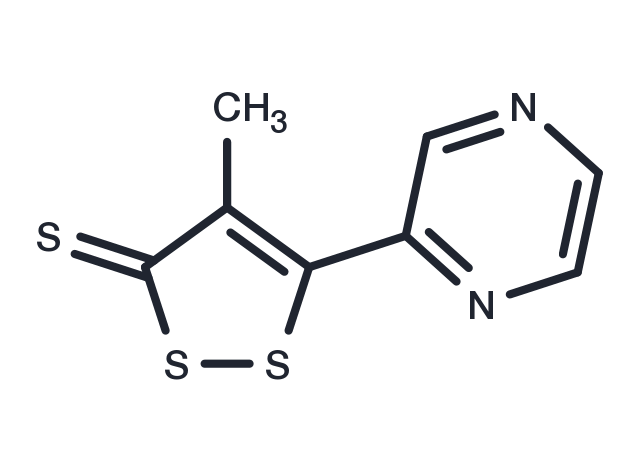Powder: -20°C for 3 years | In solvent: -80°C for 1 year
Oltipraz (RP 35972) is a synthetic dithiolethione with potential chemopreventive and anti-angiogenic properties. Oltipraz induces phase II detoxification enzymes, such as glutathione S transferase (GST) and NAD(P)H: quinone oxidoreductase 1 (NQO1). The induction of detoxification enzymes enhances the detoxification of certain cancer-causing agents, thereby enhancing their elimination and preventing carcinogen-induced DNA damages. Although the exact mechanism through which the anti-angiogenesis effect remains to be fully elucidated, oltipraz maybe able to modulate the expression of a number of angiogenic factors, thereby blocking the sustained and focal neovascularization in multiple tumor cell types.

| パッケージサイズ | 在庫状況 | 単価(税別) | |||
|---|---|---|---|---|---|
| サンプルについてお問い合わせ | |||||
| 5 mg | 在庫あり | ¥ 7,500 | |||
| 10 mg | 在庫あり | ¥ 11,500 | |||
| 25 mg | 在庫あり | ¥ 16,500 | |||
| 50 mg | 在庫あり | ¥ 20,500 | |||
| 100 mg | 在庫あり | ¥ 29,000 | |||
| 200 mg | 在庫あり | ¥ 37,000 | |||
| 1 mL * 10 mM (in DMSO) | 在庫あり | ¥ 11,500 | |||
| 説明 | Oltipraz (RP 35972) is a synthetic dithiolethione with potential chemopreventive and anti-angiogenic properties. Oltipraz induces phase II detoxification enzymes, such as glutathione S transferase (GST) and NAD(P)H: quinone oxidoreductase 1 (NQO1). The induction of detoxification enzymes enhances the detoxification of certain cancer-causing agents, thereby enhancing their elimination and preventing carcinogen-induced DNA damages. Although the exact mechanism through which the anti-angiogenesis effect remains to be fully elucidated, oltipraz maybe able to modulate the expression of a number of angiogenic factors, thereby blocking the sustained and focal neovascularization in multiple tumor cell types. |
| ターゲット&IC50 | HIF1α:10 μM |
| In vitro | Oltipraz, as a chemoprotective agent, induces Phase II detoxification enzyme activity in a Nrf2-dependent manner. [1] In human HT29 colon cancer cells, oltipraz inhibits the induction of HIF-1α by insulin, hypoxia or CoCl2 by significantly accelerating degradation of HIF-1α protein. [2] |
| In vivo | Oltipraz (500 mg/kg, p.o.) significantly reduces multiplicity of gastric neoplasia in wild-type mice by 55%, but has no effect on tumor burden in nrf2-deficient mice. [1] In BALB/c nude mice transplanted with HCT116 cells, Oltipraz (200 mg/kg, p.o.) inhibits tumor growth and angiogenesis via inhibition of HIF-1α. [2] In rats on a CDAA diet, Oltipraz attenuate the progression of nonalcoholic steatohepatitis-related fibrosis. [3] |
| キナーゼ試験 | The Src and Abl kinase assays: The Src kinase activity is measured in an ELISA format. Src (3 units/reaction), reaction buffer (50 mM Tris-HCl pH 7.5, 10 mM MgCl2, 0.1 mM EGTA, 0.5 mM Na3VO4) and cdc2 substrate peptide are added to various concentration of Bosutinib and incubated at 30 °C for 10 minutes. The reaction is started by the addition of ATP to a final concentration of 100 μM, incubated at 30 °C for 1 hour and stopped by addition of EDTA. Instructions from the manufacturer are followed for subsequent steps. The Abl kinase assay is performed in a DELFIA solid phase europium-based detection assay format. Biotinylated peptide (2 μM) is bound to streptavidin-coated microtitration plates for 1.5 hours in 1 mg/mL ovalbumin in PBS. The plates are washed for 1 hour with PBS/0.1% Tween 80, followed by a PBS wash. The kinase reaction is incubated for 1 hour at 30°C. Abl kinase (10 units) is mixed with 50 mM Tris-HCl (pH 7.5), 10 mM MgCl2, 80 μM EGTA, 100 μM ATP, 0.5 mM Na3VO4, 1% DMSO, 1 mM HEPES (pH 7.0), 200 μg/mL ovalbumin and various concentration of Bosutinib. The reaction is stopped with EDTA at a final concentration of 50 mM. The reaction is monitored with Eu-labeled phosphotyrosine antibody and DELFIA enhancement solution. |
| 別名 | NSC 347901, RP 35972 |
| 分子量 | 226.34 |
| 分子式 | C8H6N2S3 |
| CAS No. | 64224-21-1 |
Powder: -20°C for 3 years | In solvent: -80°C for 1 year
DMSO: 15 mg/mL (66.27 mM), Sonication is recommended.
You can also refer to dose conversion for different animals. 詳細
bottom
Please see Inhibitor Handling Instructions for more frequently ask questions. Topics include: how to prepare stock solutions, how to store products, and cautions on cell-based assays & animal experiments, etc.
Oltipraz 64224-21-1 Angiogenesis Chromatin/Epigenetic Immunology/Inflammation Metabolism Microbiology/Virology Proteases/Proteasome Reverse Transcriptase Nrf2 HIF/HIF Prolyl-Hydroxylase HIV Protease HIF Inhibitor Keap1-Nrf2 RP35972 inhibit HIFs Human immunodeficiency virus HIV Hypoxia-inducible factors NSC347901 NSC-347901 RP-35972 NSC 347901 RP 35972 HIF-PH inhibitor
